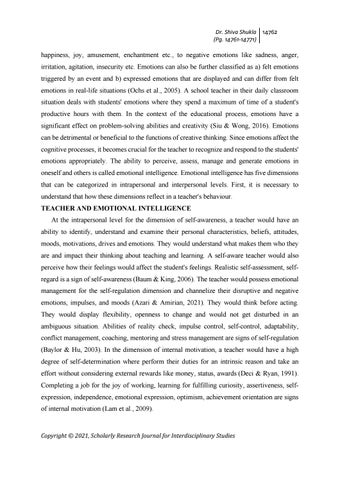Dr. Shiva Shukla 14762 (Pg. 14761-14771)
happiness, joy, amusement, enchantment etc., to negative emotions like sadness, anger, irritation, agitation, insecurity etc. Emotions can also be further classified as a) felt emotions triggered by an event and b) expressed emotions that are displayed and can differ from felt emotions in real-life situations (Ochs et al., 2005). A school teacher in their daily classroom situation deals with students' emotions where they spend a maximum of time of a student's productive hours with them. In the context of the educational process, emotions have a significant effect on problem-solving abilities and creativity (Siu & Wong, 2016). Emotions can be detrimental or beneficial to the functions of creative thinking. Since emotions affect the cognitive processes, it becomes crucial for the teacher to recognize and respond to the students' emotions appropriately. The ability to perceive, assess, manage and generate emotions in oneself and others is called emotional intelligence. Emotional intelligence has five dimensions that can be categorized in intrapersonal and interpersonal levels. First, it is necessary to understand that how these dimensions reflect in a teacher's behaviour. TEACHER AND EMOTIONAL INTELLIGENCE At the intrapersonal level for the dimension of self-awareness, a teacher would have an ability to identify, understand and examine their personal characteristics, beliefs, attitudes, moods, motivations, drives and emotions. They would understand what makes them who they are and impact their thinking about teaching and learning. A self-aware teacher would also perceive how their feelings would affect the student's feelings. Realistic self-assessment, selfregard is a sign of self-awareness (Baum & King, 2006). The teacher would possess emotional management for the self-regulation dimension and channelize their disruptive and negative emotions, impulses, and moods (Azari & Amirian, 2021). They would think before acting. They would display flexibility, openness to change and would not get disturbed in an ambiguous situation. Abilities of reality check, impulse control, self-control, adaptability, conflict management, coaching, mentoring and stress management are signs of self-regulation (Baylor & Hu, 2003). In the dimension of internal motivation, a teacher would have a high degree of self-determination where perform their duties for an intrinsic reason and take an effort without considering external rewards like money, status, awards (Deci & Ryan, 1991). Completing a job for the joy of working, learning for fulfilling curiosity, assertiveness, selfexpression, independence, emotional expression, optimism, achievement orientation are signs of internal motivation (Lam et al., 2009).
Copyright © 2021, Scholarly Research Journal for Interdisciplinary Studies
